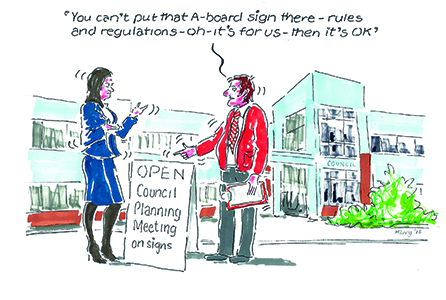High street signage
David Catanach, director of the British Sign and Graphics Association, discusses the uncertain future of pavement signs and A-boards—is their time on the nation's streets up?

Wednesday, 04 Jul 2018 11:05 GMT

There will be more demand for banners and pavement signs in high density urban areas with more foot traffic
Please see the light—and do not trip over
So, we are beginning to see ‘mission creep’. One city in the UK gets fed up with their high street pavements and overcrowded tourist locations being turned into obstacle courses with a proliferation of pavement signs. Now comes the second city, then the third, then the fourth etc. all considering the propagation of pavement signs, A-boards, and banners. Their solution? Ban them all.
The reality is if a pavement sign, for example, is on a private forecourt of business premises, then, subject to several restrictions and limitations, it is permitted with deemed consent under the regulations that apply to England, Wales, and Scotland. If it is on highway land (including public footpaths), then it is not bound by regulations. It is simply an unauthorised obstruction of the highway and falls foul of other law (the Highways Act 1980 in England, doubtless similar in Scotland). It may also be a matter of trespass—you cannot simply place something permanently or semi-permanently on someone else’s land.

Many people have no sympathy whatsoever for A-boards and the like on pavements. They are considered an obstruction”
Many people have no sympathy whatsoever for A-boards and the like on pavements. They are considered an obstruction and a nuisance and in fact, people have been known to kick them over on a busy street when obstructing their way—in the full knowledge that they cannot be committing an offence as the board should not be there in the first place. I would also consider the abundance of temporary signs such as banners adding to the perceived problem.

However, there is a school of thought that by banning advertisements/signs such as these, it could lead to a loss of revenue and taxes to the local authority, should the business fail due to lack of sales from customers being unable to locate the business or not being aware of their wares and services. The same though could be said for poor signage having the same effect as they obstruct the highway and spread with the result that no one reads any of them. But then, none of this is the sign-maker’s problem is it? Once you have been paid, so what?
Unified approach
We, the BSGA, try to get local authorities to recognise and have a unified approach as to what they can and cannot do when it comes to creating planning policies that concern advertising and signs. But it is not possible to monitor every single local authority decision or proposal, nor is it necessary to have an adversarial approach every time a local authority proposes an edict. As a business that pays its taxes, you are perfectly at liberty to monitor and engage with all those local authorities in whose bailiwicks that you sell and install signs. You too can comment or advise them on their planning policies. But we know that is not going to happen.
Our view, in the main, is that the law is clear on these temporary and pavement signs, on private land, not a problem (subject to certain conditions). On public land, you need permission—which nowadays seems more and more unlikely especially in the bigger towns and cities.
We urge local authorities to avoid treating temporary signs the same as permanent ones and to include them in their overall signs and advertising policies, because not all temporary signs are the same. Context is important.
There will be more demand for banners and pavement signs in high density urban areas with more foot traffic.
Suburban or rural areas may require taller and/or larger signs for better visibility.

Local authorities, we believe, should be more open to allowing ways in directing people to businesses in a way that does not impede the highway yet allows identification and direction in crowded areas”
Local authorities we believe should be more open to allowing ways in directing people to businesses in a way that does not impede the highway yet allows identification and direction in crowded areas. Even consider provisions for temporary signs to be used as interim signs for new businesses waiting for permanent signage to be installed.
There are many other considerations, but without dialogue leading to knowledge and a better understanding, the same old same old continues.
A-boards, or pavement signs, are often considered an obstruction when in public spaces
I will also add, some say have a moan, that basic requirements for sign maintenance should be applied to temporary/pavement signs as well. They are likely made with less durable materials than permanent signs, but may require longevity for one reason or another.
The phrase ‘best practice’ comes to mind. If only it were that simple to get everyone to buy into that.
Public Notice:
- Banning pavement signs could lead to a loss of revenue for businesses
- It is not possible to monitor every single local authority decision or proposal
- Local authorities should be more open to signage that does not impede the highway
The British Sign and Graphics Association (BSGA) history dates back more than 70 years when a group of leading sign-makers formed the Master Sign Makers Association (MSMA) with the aim of promoting the sign industry and defending its interests.
For more information on the issues discussed in this article visit www.bsga.co.uk or tel: 0845 338 3016
ffpfbdjhbsdvdveywreupfcbdhfgregaw